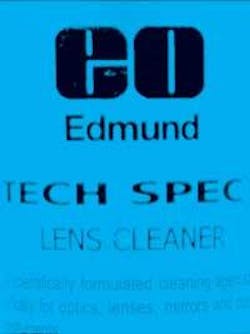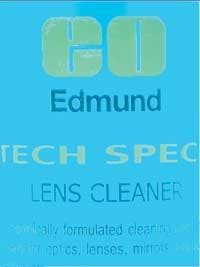Fluorescence filters enhance vision
Improved transmission and illumination yields brighter images and darker backgrounds for industrial applications.
By Jessica Gelhler
Using filters in a machine-vision system often provides a simple and economical means of enhancing the application’s speed, accuracy, or repeatability. When deciding if filters will be useful, the entire system must be taken into consideration, including illumination, optics, sensor, output, and final viewing conditions, as well as the subject being imaged. Filters can enhance or control density, focus, contrast, and glare. They also can be used in fluorescent, UV, and IR applications.
Filters work by decreasing portions of the incident radiation by absorption or reflection so that only radiation of the desired spectral quality reaches the optics and sensor. Filters cannot add any radiation to a system; a red filter cannot transmit red light if there is no red light in the radiation falling on the filter. However, they are very useful for eliminating radiation from a system by selectively determining what illumination reaches the sensor, thus enhancing a system’s signal-to-noise ratio.
There are many different kinds of filters, but, in general, they either remove incident radiation nonselectively by wavelength (neutral-density filters), selectively by wavelength (color, interference, dichroic, and notch filters), or selectively by angle of polarization. The amount of transmitted radiation is determined by the optical density of the filter. Higher-density (dark) filters block more and transmit less radiation. Filters are commonly designed to have high optical density in one spectral region (to eliminate noise) while maintaining high transmission in another spectral region (to improve the signal). However, filters also can be designed simply to balance colors, in which case lesser degrees of blocking and/or transmission are necessary.
Adding a blue color filter in front of the lens greatly increases the contrast between the yellow printing and the blue liquid.
Color filters, also known as bandpass filters, are commonly used to control contrast in black-and-white images. Knowing what colors you would like to differentiate or distinguish in your subject, you can choose lighting and filters to control contrast by using the Maxwell triangle. The triangle illustrates which colors cancel one another (red and cyan, green and magenta, yellow and blue) and which colors combine to produce another color (for example, red and green make yellow, yellow and magenta make red). The general rule is that a filter will lighten subject colors that are the same color as the filter or adjacent to that color on the Maxwell triangle (see images below).
To highlight a red subject, you would use a light source containing red light and a red filter. Magenta and yellow subjects would also be lightened, whereas blue, cyan, and green subjects would be darkened. If yellow subjects need to be lightened and red subjects darkened simultaneously, a green filter would be used (it is adjacent to yellow, but not red in the Maxwell triangle).
BORROWING FROM BIOTECH
An industry that has driven several advancements in filter technology is biotechnology, where one common application is fluorescence imaging. Fluorescence imaging in the biotechnology field makes use of light-sensitive fluorophores to mark, identify, and process cellular content. Machine-vision researchers have taken note of the advantages of this technology and are increasingly reaping the rewards of the advancement of filter performance in inspection applications.
A common problem with machine-vision inspection is extracting the most useful signal information from a product. Many defects or areas of interest do not stick out clearly from the rest of the product or other surroundings. This can cause problems not only for visual inspections, but for systems designed to take measurements. Image-processing algorithms are based on changes in density. Having low-contrast scenes may require more difficult and time-consuming image-processing programs and even make them unusable or unreliable.
Trying to inspect white or clear glue on white paper, for example, can be very difficult. Color filters cannot improve contrast, since the objects are the same color. Even if there is a slight difference in hue or value, the color fidelity and tonal sensitivity of the camera system may not be fine enough to distinguish the difference. By calculating the effects of metamerism-a phenomenon in which spectrally different materials are undistinguishable to a specific sensor or viewer-a lighting scheme can be developed to help distinguish a slight color difference not visible under most lighting conditions. However, this may be time-consuming and hard to control.
Another approach that is finding greater industry acceptance is the use of fluorescence. In the glue and paper example, the glue or paper may have brighteners in them that fluoresce under particular lighting. Adding a fluorophore (or fluorescent whitening agent) to products is an option if they are not already fluorescent. Many textiles, paints, plastics, ceramics, and cleaners contain fluorophores, often called “optical brighteners.”
To take advantage of fluorescent materials, filters are needed. Filters can be used to control the incident excitation light and the fluorescence emitted from the subject. Usually an exciter filter is used over the radiation source, and a barrier filter (or emitter filter) is used over the camera lens. The exciter filter only passes wavelengths that will cause the product to fluoresce. Ultraviolet light sources can be used for strong illumination. To obtain the desired contrast, a filter is placed over the camera lens to transmit the longer wavelengths produced by the fluorescent material.
BANDPASS OPTIONS
Filter lifetime, acceptance angle, and overall transmission are several inherent problems with traditional narrow-bandpass interference filters that have prevented the acceptance of filters for industrial machine-vision applications. A new generation of “hard-coated” fluorescence filters, however, is now available with extremely durable and efficient coatings.
Traditional narrow-bandpass interference filters consist of up to 50 layers of dielectric materials, several glass substrates, and metallic thin-film coatings. This method leads to several problems. First, the multiple layers reduce transmission at all wavelengths, including the design passband wavelengths. Second, the multilayered construction of the filters makes them difficult to use in imaging applications, because accurate ray-tracing through the many layers is not possible and repeatable construction of the filters is difficult and costly. Loose tolerancing in the overall thickness and on the center wavelength is common. Finally, because the epoxy and often the coating materials themselves have poor mechanical and optical durability and are prone to swelling and degradation induced by humidity, the overall reliability of the filters is limited. “Hard” ion-beam-sputtered coating eliminates the problems inherent to traditional interference filters. Dielectric films of arbitrary thickness are deposited on a single substrate, eliminating the need for complex cavity designs and epoxy layers. With arbitrary film thicknesses and capabilities to deposit up to 200 layers, excellent transmission and broad spectrum blocking can be achieved entirely by the dielectric coatings applied to the substrate. Transmissions typically exceed 90% at the design wavelength, with much steeper edges and deeper blocking. The combination of improved signal transmission and ambient illumination rejection simultaneously yields brighter images and darker backgrounds, greatly improving system signal-to-noise ratio.
Thus, the use of fluorescence filters, originally designed for biotechnology, can greatly enhance the capabilities of a machine-vision system. The improved signal-to-noise ratio greatly simplifies the needed complexity of the imaging-processing algorithm, which greatly improves yield and throughput of the overall system. While these filters are certainly much more expensive than standard color, dichroic, and polarizing filters traditionally used in vision systems, because of their increased durability and superior performance they pay for themselves almost immediately.
Jessica Gelhler is an applications engineer at Edmund Industrial Optics, Barrington, NJ, USA; www.edmundoptics.com.


